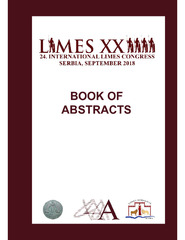Приказ основних података о документу
Commemoration of children in the province of Upper Moesia – evidence from limes and its hinterland
| dc.creator | Marjanović, Milica | |
| dc.date.accessioned | 2024-01-04T15:15:09Z | |
| dc.date.available | 2024-01-04T15:15:09Z | |
| dc.date.issued | 2018 | |
| dc.identifier.isbn | 979-86-6439-039-2 | |
| dc.identifier.uri | http://rai.ai.ac.rs/handle/123456789/1364 | |
| dc.description.abstract | Recent discovery of a sarcophagus in Viminacium. Evidence of mors immatura? Ilija Dankovió, Ilija Mikió The deaths of young individuals is usually perceived as a failure on behalf of the parents, and of society in general. It is regarded that death of a member of these social groups is premature, that it came before they have reached their full potential or before they fulfilled goals expected of them during their life. In various cultures, burials of such individuals differ from the norm, and it can be expected that they should be recognizable in the archaeological record. One of the categories of this so-called mors immatura consists of young women eligible for marriage who died before having the chance to actually get married, with the subcategory of ones who did accomplish that goal but died before giving birth to any offspring. The emotions of relatives of the deceased were often translated into material culture through rich grave fur-nishings and choice of specific objects, which was the case in the Mediterranean basin in the Roman period. "Exceptionally lavish" graves of young women were identified in recent scholarly articles as the resting places of young women and girls who were denied marriage or childbirth. The latest excavations in Viminacium resulted in the discovery of an intact sarcophagus. In it were the remains of two individuals, probably members of the family that owned the nearby villa rustica. Preliminary bioarchaeological reports showed that one of the skeletons belonged to a female in her early twenties, while the other individual was male over 45 years of age. Gold and silver objects placed with the woman, as well as hairpins made of jet, could lead to the conclusion that she died before getting married, or at least before bearing children to whom she could bequeath the jewelry. Possible scenarios will be explained through the means of material culture studies and life course theory, and various scientific methods will be employed in order to test the hypotheses presented. Commemoration of children in the province of Upper Moesia - evidence from limes and its hinterland Milica Marjanovió Studying of infancy and childhood experiences is essential for understanding social relations in Roman culture. Children had a significant role in Roman society, especially regarding main-taining and passing on traditional family values. Apart from continuing their family name and managing the family's property and affairs, they were expected to retain and improve the social status of their family. Children were obliged to demonstrate pietas towards their parents and look after them in their old age. Romans were confronted with a high mortality rate of children, which resulted in special atten-tion being paid to funerary customs and commemoration. Funerary monuments are an excel-lent source for studying the attitude toward children in different parts of the Roman Empire, especially since children do not leave behind a significant number of visible traces in material culture. In addition to basic information about their age, name and the possible ethnic origin, tombstones provide insight into a society in which they lived, cultural and social identity of their parents, as well as family relations. This paper will examine tombstones dedicated to children from the Upper Moesian Limes and its hinterland. The research will be based mainly on analysis of inscriptions and relief repre-sentations on tombstones. The aim of this paper is to find out if and how the monuments of children of various age, gender and social background (e.g. families of soldiers/veterans or civilians) differ. Certain patterns in the manner of portraying, commemorative formulas, types and decoration of monuments are likely to be recognised. | sr |
| dc.language.iso | en | sr |
| dc.publisher | Beograd : Arheološki institut | sr |
| dc.rights | openAccess | sr |
| dc.source | 24. Limes Congress Serbia 02-09 September 2018 Belgrade – Viminacium, Book of abstracts | sr |
| dc.subject | Roman Iconography | sr |
| dc.subject | Roman epigraphy | sr |
| dc.subject | Roman childhood | sr |
| dc.subject | Roman funerary commemoration | sr |
| dc.title | Commemoration of children in the province of Upper Moesia – evidence from limes and its hinterland | sr |
| dc.type | conferenceObject | sr |
| dc.rights.license | ARR | sr |
| dc.identifier.fulltext | http://rai.ai.ac.rs/bitstream/id/1947/bitstream_1947.pdf | |
| dc.identifier.rcub | https://hdl.handle.net/21.15107/rcub_rai_1364 | |
| dc.type.version | publishedVersion | sr |


